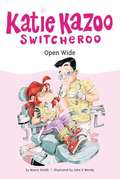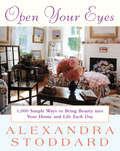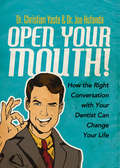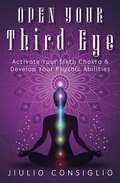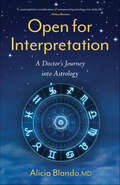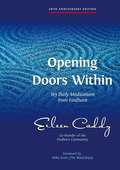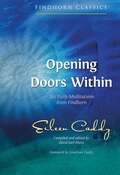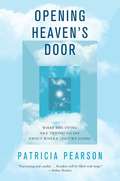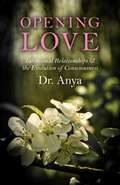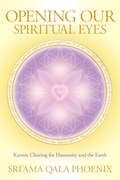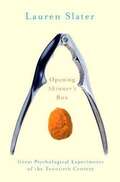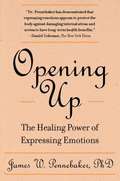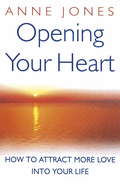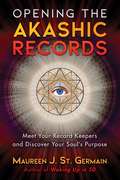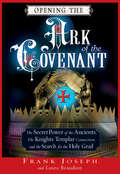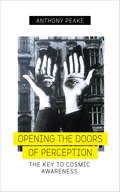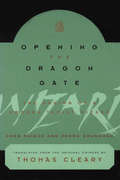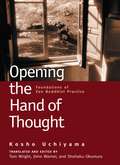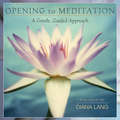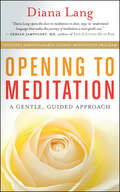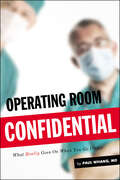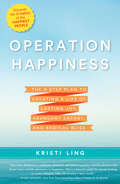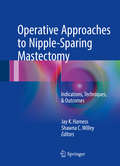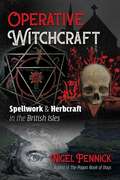- Table View
- List View
Open Wide (Katie Kazoo Switcheroo #23)
by Nancy KrulikHere a funny adventure that kids can really sink their teeth into! When Emma's brother Matthew overhears Katie talking about how awful going to the dentist is, he's terrified. So Katie accompanies him to Dr. Sang in the hopes of calming Matthew down.
Open Your Eyes
by Alexandra StoddardFor nearly forty years and in numerous books, Alexandra Stoddard has shared her keen eye for design and sure sense of style. Now this renowned decorator and lifestyle philosopher teaches you hoe to see with the expertise and clarity of professional designers. First, Alexandra helps you become more attuned to your surroundings-as you set a table, straighten out a linen closet, stroll through a garden, or browse in a thrift shop. Then, through personal anecdotes; examples from masters; a rich array of ideas, tips, and techniques, she reveals hundreds of ways to see and solve problems or proportion, pattern, color, and composition. Her simple suggestions-whether it's changing a lampshade, rearranging treasured objects on a table, or moving a chair-will yield dramatic results. Filled with practical solutions offered with warmth and encouragement , Open Your Eyes helps make each day a visual feats as it deepens your understanding not only of what makes something beautiful but what makes something beautiful to you.
Open Your Mouth!: How the Right Conversation with Your Dentist Can Change Your Life
by Dr. Christian Yaste Dr. Joe HufandaYour smile and oral health are all about how your teeth look and the way everything in your mouth fits together, whether it’s a crown, a bridge, dental implants, veneers, or fillings. All of this adds up to how your mouth makes you feel about yourself—your self-image. All too often people are not informed enough going in and don’t know the right questions to ask their dentist to ensure a treatment plan is optimal for their needs, wants, and wallet. No two dental patients are alike, and with enormous strides in the nature of dental practices, technology, and materials, settling for one-size-fits-all dentistry is not necessary today. Open Your Mouth: How the Right Conversation With Your Dentist Can Change Your Life is geared toward members of the Baby Boom generation and their unique dental needs and desires, showing them how to navigate the world of dentistry.
Open Your Third Eye: Activate Your Sixth Chakra & Develop Your Psychic Abilities
by Jiulio ConsiglioExpand Your Consciousness and Unlock Your Hidden Potential with the Power of the Sixth ChakraThe third eye is your gateway to greater insight, clarity, and confidence. When it's activated, you can access your inner compass and enhance your spiritual gifts. Filled with simple yet effective exercises and meditations, this illuminating guide provides everything you need to empower your psychic life.Everyone can open their third eye; everyone has abilities just waiting to be discovered and developed. Jiulio Consiglio shares powerful methods for tuning in to your intuition, trusting your gut, releasing negative thoughts and emotions, protecting yourself, and more. Open Your Third Eye helps you understand who you are on a spiritual level, receive messages from spirit guides, and raise your vibrational frequency. Each chapter features step-by-step instructions you can use daily to improve your skills. With this book, you can optimize the flow between your physical and subtle energy bodies.
Open for Interpretation: A Doctor's Journey into Astrology
by Alicia BlandoAs a young doctor working in the middle of the HIV epidemic in the early ’90s, Alicia Blando feels unsure of the effectiveness of the medical profession. To gain insight into her life’s path, she seeks advice in some unconventional places, and lands on astrology as her way forward. Astrology, based in astronomy, has specific rules; it can’t be easily manipulated. The scientist in her can’t help but respond to this idea.At a pivotal group demonstration, Alicia finds a mentor, Iris, who introduces her to the study of astrology. By learning to read the horoscope, Alicia gains insight into her potential and manifests her ambition to travel and explore healing techniques from indigenous cultures. Eventually, her search for new teachers and past knowledge takes her from Manhattan to the Peruvian Amazon, Belize, and Bolivia, where she discovers ancient ways of healing among people who consider the sky to be a continuation of nature on earth. She connects with the tenets of astrology as the language that describes man’s connection to the sky environment. The horoscopic map gives information that can assist in making better choices in life, Alicia learns; it has the potential to analyze a person’s strengths, weaknesses, opportunities, and health concerns. Alicia’s journey off the beaten path ultimately leads her to true self-exploration and connection with the world around her, as well as a desire to share her knowledge. In Open for Interpretation, she shares her story of finally finding the map she’s been seeking—and explains how we can all use that map to access our true selves and untapped potential.
Opening Doors Within
by Eileen Caddy Mike ScottFor 20 years, meditators have relied on these simple teachings which offer advice on faith, fulfillment, and stillness. Serving as a perennial meditational diary, this new edition presents inspirational and practical messages for everyone embarking upon the journey to find a true inner self and spiritual truth. Anyone who meditates-whether inexperienced or seasoned-will find these adages helpful and inspirational. A new foreword, layout, and revised illustrations create an accessible and uplifting treatise on daily spiritual satisfaction and internal happiness.
Opening Doors Within: 365 Daily Meditations from Findhorn
by Eileen CaddyA new edition of the much-loved perennial meditation diary whose messages radiate spiritual wisdom, encouragement and serenity throughout the year • Provides messages of spiritual insight and guidance for every day of the year from Eileen Caddy, co-founder of the Findhorn Community • Offers specific suggestions for your daily spiritual growth and development • Includes a new introduction by Jonathan Caddy, one of Eileen’s sons, who adds a fresh perspective to the profound influence this guidance can have One of the much-loved books of Eileen Caddy (1917-2006), co-founder of the Findhorn Community in Scotland, Opening Doors Within is a perennial meditation diary offering down-to-earth inspirational messages of spiritual guidance for every day of the year. For over 35 years, people have used these practical teachings that offer advice on achieving stillness, faith, and fulfillment. Specific suggestions for your daily spiritual growth and development enhance the impact of the supportive words. Eileen’s brief messages, from what she called “the still, small voice within,” offer inspirational, uplifting, and powerful words of love and support. Her daily guidance was the bedrock of the early Findhorn Community, and the concept of “inner listening” is still very much part of individual and community practice there today. The encouraging and practical messages speak to those embarking upon the journey to find their divine inner self and spiritual truth. Anyone who meditates--whether inexperienced or seasoned--will find the wisdom shared both insightful and heartening. A new foreword by Jonathan Caddy, Eileen’s son who lives in the Findhorn Community, adds a fresh perspective to the profound influence this guidance can have. No matter how you use the wisdom shared in this small book, take these teachings into yourself and carry them within you, until they have done their silent, gentle, and loving work of opening the doors within.
Opening Heaven's Door
by Patricia PearsonPeople everywhere carry with them extraordinary, deeply comforting experiences that arrived at the moment when they most needed relief: when they lost a loved one. These experiences can include clear messages from beyond, profound and vividly beautiful visions, mysterious connections and spiritual awareness, foreknowledge of a loved one's passing--all of which evade explanation by science and logic. Most people keep these transcendent experiences secret--deathbed experiences, Nearing Death Awareness, and shared death experiences. Individuals and families guard them for fear they will be discounted by hyperrational scrutiny. Yet these very common occurrences have the power to console, comfort, and even transform our understanding of life and death. Prompted by her family's surprising, profound experiences around the death of her father and her sister, reporter Patricia Pearson sets out on an open-minded inquiry, a rare journalistic investigation of Nearing Death Awareness. Pearson discovers that roughly half of bereaved people, as well as nurses, hospice workers, soldiers, and others who constantly observe the dying, have had intimations of enduring bonds that can radically help people to process their grief and their fear. Opening Heaven's Door offers deeply affecting stories of messages from the dying and the dead in a fascinating work of investigative journalism, pointing to new scientific explanations that give these luminous moments the importance felt by those who experience them. Pearson also delves into out-of-body and near-death experiences, examining stories and research to make sense of these related but distinct categories that shed light on Nearing Death Awareness. Countless people experience these coincidences when a loved one dies, while others experience such visions while they are dying themselves. These phenomena point toward a larger spiritual reality, and the reality of life (or something else) after death, yet are ignored in a cultural framework that dismisses anything that cannot be explained by the physical brain. But by dismissing or discounting these occurrences, we hamper our own healing. Challenging current assumptions about what we know and what we are still unable to explain, Opening Heaven's Door is a groundbreaking, beautifully written exploration that will forever alter your perceptions of the nature of life and death.
Opening Love: Intentional Relationships & the Evolution of Consciousness
by Dr. Dr. AnyaLove, sex, and relationship wisdom from the polyamory movement are offered in this practical guide to spiritual enlightenment. Contrary to popular belief, monogamy and celibacy are not the only two options for exploring a spiritual path. In Opening Love, Dr. Anya translates the lessons learned by the pioneers of the polyamory (many loves) movement for readers who actively pursue personal growth through spiritual practice. Drawing on both personal experience and philosophical reflection, this nonfiction guide explains how to cultivate intentional, creative, non-conventional relationships that center on principles of honesty and consent. Instead of committing solely to a single person, spiritual seekers can instead commit to pursuing openness and courage in all their interactions. As polyamorists understand: love, sex, and relationships are not scarce commodities, rather they are an abundant resource for healing and evolving one's consciousness. With eloquence and precision, Dr. Anya describes how to cultivate compersion (the opposite of jealousy), find an intentional community based on common core values, and build advanced emotional and communication skills. Meditation and reflection practices are offered throughout, to create an interactive, truly transformative learning experience.
Opening Our Spiritual Eyes
by Sriama Qala PhoenixKarma is generally understood as personal, and clearing karma is often considered an individual effort, with individual rewards. In Opening Our Spiritual Eyes, spiritual teacher Sri'ama Qala Phoenix shows how karmic clearing can also be used in collective healing. Karma is shared within families and communities, and clearing karma releases it from the etheric body of our children and future generations. The book was inspired by the ongoing "Celestial Project," a four-year global endeavor of Australia's Divine University that began in 2009. The project involves people gathering worldwide on specific dates to focus on the karmic cleaning of the etheric body of a major city.Opening Our Spiritual Eyes draws on the author's experiences of meeting the Enlightened Masters, those wise spirit guides who, through her, present new understandings of the collective karma held within the world's primary cities and our etheric bodies--and how to free ourselves, our families, and our world from it with grace. Revealing what Sri'ama Qala Phoenix calls "the true nature of the divine plan for humanity and our Earth," the book shares essential keys for how we can become empowered to live in alignment with our divine purpose.From the Trade Paperback edition.
Opening Skinner's Box: Great Psychological Experiments of the Twentieth Century
by Lauren SlaterThrough examples of experiments by some of psychology's innovative thinkers, Slater traces the evolution of the century's most pressing concerns-free will, authoritarianism, conformity, morality.
Opening Up: The Healing Power of Expressing Emotions
by James W. PennebakerUsing original research, Dr. James Pennebaker presents astounding evidence for the health benefits of personal self-disclosure, offering sound advice on how each of us can confront and conquer buried turmoil and get on the road to good health.
Opening Your Heart: How to Attract More Love into Your Life
by Anne JonesDo you have difficulty finding the right partner? Have you ever worried about being alone? Do you feel that there must be more to life? In Opening Your Heart, healer Anne Jones demonstrates that by opening our hearts to love, we can change our relationships and our lives profoundly. She believes that we all deserve to share in an infinite amount of love, and that each one of us can achieve this if we are willing to examine and heal our emotional hearts. Here is a unique chance to open yourself up to love, address your true emotions, forgive those who have hurt you in the past and reinforce and strengthen your current loving relationships.In this book, you will discover:-How to attract love and loving people into your life -How to make your relationships more loving -How to increase your capacity for love -How to break down the barriers you have created against love -How to heal your heartbreaks.
Opening Your Heart: How to attract more love into your life
by Anne JonesDo you have difficulty finding the right partner? Have you ever worried about being alone? Do you feel that there must be more to life? In Opening Your Heart, healer Anne Jones demonstrates that by opening our hearts to love, we can change our relationships and our lives profoundly. She believes that we all deserve to share in an infinite amount of love, and that each one of us can achieve this if we are willing to examine and heal our emotional hearts. Here is a unique chance to open yourself up to love, address your true emotions, forgive those who have hurt you in the past and reinforce and strengthen your current loving relationships.In this book, you will discover:-How to attract love and loving people into your life -How to make your relationships more loving -How to increase your capacity for love -How to break down the barriers you have created against love -How to heal your heartbreaks.
Opening the Akashic Records: Meet Your Record Keepers and Discover Your Soul’s Purpose
by Maureen J. St. GermainA clear and simple manual of precise instructions for accessing the Akashic Records and confirming the accuracy of the information you receive • Details exercises, tools, and techniques to clear the energies blocking your access and tune to your Akashic Record Keepers • Explains the specific markers that allow you to recognize your Record Keepers and to validate the information you receive, rather than “trusting” it to be true • Provides guidance on accessing the Akashic Records on behalf of other people, how to ask questions, and how to handle the information as it comes in The Akashic Records are a vast domain of energetic imprints much like a movie library, a living vibrational field that stores all possible futures, the present, and the past. As soon as your soul begins its life experience, a field of energy is released that records every thought, word, action, desire, and emotion. In this guide to opening the Akashic Records, Maureen St. Germain provides precise instructions explaining how to connect with your personal Record Keepers, gain clear access to the Akashic Records, discover information about you and your loved ones, and learn your soul’s purpose. The author explains how outside energies can influence your connection to the Akashic Records. She details energetic clearing exercises to remove the energies blocking or shadowing your access and teaches the Higher Self Protocol to ensure an authentic channel of communication. She explores how to find the Record Keepers who will be the most helpful to you and provides techniques and tools, such as guided energy work, to prepare you for Akashic Record access, initiate you into the 5D mindset, and invite more accuracy and a stronger connection. She details the specific markers to look for to recognize genuine Akashic Librarians and to validate and confirm the information you receive, rather than simply “trusting” it to be true. She also provides guidance on accessing the Akashic Records on behalf of other people, how to ask questions, and how to handle the information as it comes in. Explaining why the Ascended Masters opened access to the Akashic Records to all of humanity and how their presence assists you, St. Germain shows how the intended purpose for working with the Akashic Records is for soul growth, not to “repair” your karma debts. By seeing your records and working with your Record Keepers, not only will you learn your soul’s purpose and help solve the problems that crop up in everyday life and relationships, but you will amplify your spirituality and begin operating at a higher level in consciousness. Your work in the Akashic Records aids and assists in Earth’s ascension.
Opening the Ark of the Covenant: The Secret Power of the Ancients, the Knights Templar Connection, and the Search for the Holy Grail
by Frank Joseph Laura BeaudoinThrough his worldwide research into its disappearance, author Frank Joseph has learned that the Ark was not a mere legend; nor was it just an elaborate box used to store the original Ten Commandments. It was, he asserts, purpose-built to harness the powers of the Earth for humanity's continued physical existence and spiritual evolutions.
Opening the Doors of Perception: The Key to Cosmic Awareness
by Anthony PeakeIn 1954 Aldous Huxley's hugely influential book "The Doors of Perception" was published. Huxley's title is taken from William Blake's 1793 book "The Marriage of Heaven and Hell". In this Blake makes the following observation: "If the doors of perception were cleansed every thing would appear to man as it is, Infinite. For man has closed himself up, till he sees all things thro' narrow chinks of his cavern." Opening the Doors of Perception will update Huxley's work and suggest process and procedures whereby man can, indeed, perceive reality in its true glory. The book will be in two sections. The first will discuss in great detail a concept I first introduced in my book The Daemon: A Guide to Your Extraordinary Secret Self. I termed this the "scale of transcendence" and suggested that there is a scale of perceptions whereby the doors of perception are slowly opened and, bit by bit, they reveal the true nature of "reality" as suggested by most esoteric teachings and mystic traditions. Most human beings perceive the doors as being securely closed. However there are occasions when the doors become slightly ajar and allow fleeting glimpses of what the Gnostics called "The Pleroma". For "normal" people these glimpses are experienced during fleeting "noetic" experiences. However forothers the doors are prized upon by certain neurological processes starting with migraine and progressing through various "altered-states" such as temporal lobe epilepsy, bi-polar syndrome, autism and finally, when the doors are fully open, schizophrenia.
Opening the Dragon Gate
by Thomas Cleary Zheng Shunchao Chen KaiguoThis authorized biography of the contemporary Taoist expert Wang Liping (1949 -) tells the true story of his apprenticeship in Taoist wizardry, as well as Taoist principles and secrets of inner transformation. The 18th-generation transmitter of Dragon Gate Taoism, Wang Liping is heir to a tradition of esoteric knowledge and practice accumulated and refined over eleven centuries. This is the first English translation by noted writer Thomas Cleary of the authorized biography by two longtime disciples of this living master of the Dragon Gate branch of the Complete Reality school of Taoism, which integrated Buddhism and Confucianism into a comprehensive new form of Taoism.
Opening the Hand of Thought
by Tom Wright Shohaku Okumura Jisho Warner Kosho UchiyamaFor over thirty years, Opening the Hand of Thought has offered an introduction to Zen Buddhism and meditation unmatched in clarity and power. This is the revised edition of Kosho Uchiyama's singularly incisive classic. This new edition contains even more useful material: new prefaces, an index, and extended endnotes, in addition to a revised glossary. As Jisho Warner writes in her preface, Opening the Hand of Thought "goes directly to the heart of Zen practice... showing how Zen Buddhism can be a deep and life-sustaining activity." She goes on to say, "Uchiyama looks at what a person is, what a self is, how to develop a true self not separate from all things, one that can settle in peace in the midst of life." By turns humorous, philosophical, and personal, Opening the Hand of Thought is above all a great book for the Buddhist practitioner. It's a perfect follow-up for the reader who has read Zen Meditation in Plain English and is especially useful for those who have not yet encountered a Zen teacher.
Opening to Meditation: A Gentle, Guided Approach
by Diana LangIn this beautiful book and downloadable audio companion, Diana Lang demonstrates that meditation is as simple as breathing. There is no mystery to it. Her pleasant, straightforward guidance makes meditation available to all. Along the way, she shows us the numerous benefits to be gained from meditation, and she writes and speaks beautifully about breathing, acceptance, intention, and the power of love.
Opening to Meditation: A Gentle, Guided Approach
by Diana LangBreathe, Be Still, and Listen Diana Lang’s books, audio programs, webinars, and workshops have allowed thousands to access the physical, psychological, and spiritual benefits of meditation. Drawing on her wide experience in studying spiritual teachings from around the world, Lang has put together a gentle, guided approach to meditation that is very easy to implement. In Opening to Meditation, she demonstrates that meditating is as simple as breathing. There is no mystery to it. Her instruction goes to the core, avoiding the analytical theory, fixed rules, and intellectual razzmatazz that often intimidate would-be practitioners. Instead, she shows us how to reconnect with our foundational essence of soul and self, where peace and centeredness are always and everywhere available. Includes downloadable guided-meditation program
Operating Room Confidential: What Really Goes On When You Go Under
by Paul WhangEven patients who’ve spent time in the operating room don’t really know much about them—thanks to the important work of anesthesiologists like Dr. Paul Whang. But here, he takes readers into the hospital and past the OR doors—fully alert. Combining personal stories with staff experiences, he reveals hidden truths about what goes on during surgery and recounts both the humdrum and the quirky, strange, and bizarre occurrences that shape a regular hospital day. Answering questions such as What do doctors talk about during surgery? and If a surgical instrument falls to the floor, is the five-second rule observed?, this is a must-read for anyone who’s ever wondered how realistic shows like ER, Grey’s Anatomy, and House really are.
Operation Happiness: The 3-Step Plan to Creating a Life of Lasting Joy, Abundant Energy, and Radical Bliss
by Kristi LingIn Operation Happiness, happiness strategist and life coach Kristi Ling teaches you how to create immediate, positive shifts in your life by proving that happiness is a skill that can be cultivated, learned, and mastered--much like playing an instrument. After experiencing a long-term illness, a divorce, and the sudden deaths of loved ones, Ling spent years studying the science of happiness. She focused on identifying and testing specific emotional support tools. During this process, she discovered something that goes against everything we've been lead to believe about happiness: it isn't just something you feel; it's something you do. Based on this discovery, Ling outlines the three foundational principles that lead to a life of joy: Change Your View, Make Over Your Mornings, and Create New Habits.Part memoir and part how-to guide, Operation Happiness combines compelling personal stories, inspiring perspective shifts, and clear actionable steps to help you create a solid foundation for sustainable happiness that will propel you into a new, light-filled way of living.
Operative Approaches to Nipple-Sparing Mastectomy
by Jay K. Harness Shawna C. WilleyThis text is designed to present a comprehensive overview of the evolution, oncologic safety, surgical approaches and outcomes of NSM. The book is targeted at general surgeons, dedicated breast surgeons, and plastic surgeons. There is focus for surgeons just beginning their use of NSM, as well as a review of patient selection criteria, operative approaches, reconstruction options, and management of complications. Chapters are written by experts in the performance and reconstruction of NSM. Chapters are supplemented with appropriate illustrations, photos, and video demonstrations of NSM techniques and reconstructions. Operative Approaches to Nipple-Sparing Mastectomy: Indications, Techniques, & Outcomes will become a valuable resource for surgeons, including those in-training, who have a focus on state-of-the-art breast cancer surgery.
Operative Witchcraft: Spellwork and Herbcraft in the British Isles
by Nigel PennickA comprehensive look at the history and practices of rural English witchcraft • Explores witch’s familiars and fetches, animal magic, and the forms of witchcraft practiced by rural tradespeople, such as blacksmiths, herbalists, and artisans • Offers practical insight into spells, charms, folk incantations, herbal medicine practices, amulets, sigils, and tools of the craft • Details the evolution of public perception of witchcraft throughout England’s history, including the laws against witchcraft in place until the 1950s and witchcraft’s contentious relationship with the Christian church In this practical guide, Nigel Pennick takes the reader on a journey through the practice of operative witchcraft in the British Isles from the Middle Ages and the Elizabethan era to the decriminalization of witchcraft in the 1950s and its practice today. Highlighting uniquely English traditions, Pennick explores fetches and witch’s familiars, animal magic, and the forms of witchcraft practiced by rural tradespeople, such as blacksmiths, herbalists, and artisans, to enhance their professional work and compel others to do their bidding, both man and beast. He provides actual spells, charms, and folk incantations, along with details about the magical use of a variety of herbs, including nightshades, the creation of amulets and sigils, protection against the Evil Eye, and the use of aromatic oils. Pennick explains the best times of day for different types of magic, how to identify places of power, and the use of the paraphernalia of operative witchcraft, such as the broom, the witches’ dial, and pins, nails and thorns. He explores the belief in three different types of witches: white witches, who offer help and healing for a fee; black witches, who harm others; and gray witches, who practice both white and black magic. Examining witchcraft’s contentious relationship with the Christian church, he investigates the persecution of witches throughout the UK and the British West Indies up until the mid-20th century. He offers a look into the changing public perceptions of witchcraft and the treatment of its followers as well as revealing how English churchmen would offer magical solutions to the perceived threat of black witchcraft. Painting an in-depth picture of English witchcraft, including how it relates to and differs from modern Wicca, Pennick reveals the foundation from which modern witchcraft arose. He shows how this context is necessary to effectively use these ancient skills and techniques and how the evolution of witchcraft will continue harmonizing the old ways with the new.
